| |
|
CULLODEN MOOR
AND
STORY OF THE BATTLE.
WITH DESCRIPTION OF THE
STONE CIRCLES AND CAIRNS AT CLAVA
BY THE LATE
PETER ANDERSON
OF INVERNESS 1867
New and Revised Edition
STIRLING
ENEAS MACKAY, 43 MURRAY PLACE
INVERNESS: WILLIAM MACKAY & SON.
1920 |
|
Images added by John A
Duncan of Sketraw, FSA Scot. |
|
| |
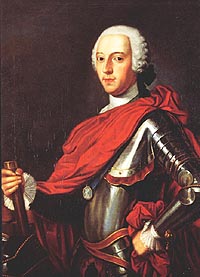 |
|
Charles Edward Stuart |
|
Bonnie Prince Charlie |
|
|
AUTHOR'S PREFACE, 1867.
HAVING been for some years resident in the neighbourhood of the Culloden
[now Allanfearn] Railway Station, the Author's attention has been a good
deal engaged with the scene and incidents of the expiring struggle of the
Stuart dynasty, and the last battle fought on British ground. The Culloden
family take a warm interest in all matters connected with the action; and
though the battle of Culloden has been repeatedly described in the course of
works of more general history and disquisition, the circumstances are
becoming unfamiliar to the public at large; and it has been thought that a
separate account, embracing a survey of what has been said on various
controverted points by different writers, with the addition of more minute
topographical details, and the aid of received local tradition, might be
acceptable, more especially to strangers visiting the field of battle. . . .
The Plans have been accurately and tastefully prepared by Mr. James Fraser,
land and engineering surveyor, Inverness; and to his labours much of any
success which may attend the publication will fall to be ascribed. . . .
It has been deemed proper to add a description of the interesting collection
of Stone Circles and Cairns at Clava, in the near vicinity of the
battle-field, as well deserving inspection. . . .
P.A.
INVERNESS, lst July, 1867.
ADDITIONAL NOTE, 1920.
Half-a-century ago my father believed that the circumstances connected with
the Forty-Five were becoming unfamiliar to the public at large. The last
fifty three years have seen a renascence of interest in the Stuart risings,
and the printing of a number of contemporary records has led to a juster
estimate of the events that culminated on Culloden Moor. and of the actors
that played their parts therein.
It has, however, been represented to me that the place filled by my father's
little book - which has been long out of print - has not been otherwise
occupied; and filial piety readily prompts me to agree to Mr. Mackay's
suggestion that it should be reprinted with such alterations as are called
for by recent changes in the locality, and its means of access. No attempt
has been made to introduce fuller historical details, but a short list has
been appended of the more authoritative recent works in which such details
may be found.
It is a source of peculiar gratification to express indebtedness to Mr.
James Fraser, who has renewed in 1920 his services to the book, which my
father acknowledged in 1867.
P.J.A.
ABERDEEN UNIVERSITY, 1st July, 1920.
|
|
CHAPTER 1
EVENTS BEFORE THE BATTLE
PRINCE CHARLES EDWARD's
army commenced its memorable march into England, from its position near
Dalkeith, on the 1st of November, 1745. It consisted of about 6000 foot,
one-half Highlanders, and some 500 cavalry; but when mustered at Carlisle
their number was found to be reduced by desertion to about 4500, to whom
were added at Manchester 200 to 300 recruits. With this small force the
Insurgents penetrated to Derby, within 127 miles of London. Here they
learned that they were being environed by three armies, amounting to 30,000
men - one under General Wade at Newcastle; a second, composed of veteran
troops, under William, Duke of Cumberland, in Staffordshire; and a third,
less formidable, mustered on Finchley Common, - while reinforcements ordered
from Scotland were not on the way. In the lack of all co-operation, the
leaders, to the Prince's deepest chagrin and bitter disappointment, and
equally to the mortification of the inferior ranks, deemed it indispensable
to make a timely retreat.
The retrograde movement, concerted with great secrecy, accordingly on the
morning of the 6th December, and was conducted with much skill and complete
success. The invasion had been regarded at first with supineness by the
English, as a piece of mere infatuation; and the leading Jacobites in
England and Wales hung back, from distrust of the fortunes of so small a
force. By this time, however, the nation and the government were thoroughly
alarmed, and many well-wishers were on the very eve of joining the
insurrection; while the French Ministry had made serious preparations for a
large armament, and 10,000 troops were mustered, in order to a descent on
the south of England. So it is probable that, had the Prince's eagerness to
risk all the hazards of the die prevailed, his romantic enterprise might
have achieved at least the temporary reinstatement of the Stuarts on the
throne of Britain.
The Insurgents retreated by Carlisle, Dumfries, Nithsdale, Hamilton, and
Glasgow. They left the latter city on the 3rd of January, 1746, and occupied
Falkirk and villages between that town and Stirling, which place the Prince,
waiting reinforcements from the North, set about reducing. |
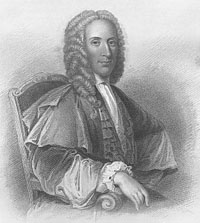 |
|
|
Duncan Forbes of Culloden |
|
|
AFFAIRS IN THE NORTH
During the absence of the Prince's forces in England, Duncan Forbes of
Culloden, Lord President of the Court of Session, had continued the
strenuous labours whereby he was so instrumental in rendering the Rising
abortive, by persuading many of the most powerful of the Highland chiefs to
hold aloof; and having been intrusted with commissions for the purpose,
accompanied by a mere promise of repayment of his advances, but with no
supply of money, he succeeded in embodying at his own expense, as
Independent companies, nearly 2000 Highlanders in the service of government,
who rendezvoused at Inverness, and who, though perhaps but lukewarm in the
Royal cause, were thus kept from swelling the ranks of insurrection. They
were placed under command of the Earl of Loudoun. Possession of Inverness
was thus preserved for government till the return of the Prince, and the
spread of disaffection was powerfully counteracted. |
|
The difficulties and dangers of the President's position are thus described
by himself:-
| |
"The prospect [of
dissuading the chiefs] was at first very flattering, and the errand I came
on had no appearance of difficulty; but the Rebels' successes at Edinburgh
and Prestonpans soon changed the scene. All Jacobites, how prudent soever,
became mad, all doubtful people became Jacobites; and all bankrupts became
heroes, and talked nothing but hereditary rights and victory; and what was
more grievous to men of gallantry, and, if you will believe me, much more
mischievous to the public, all the fine ladies, if you will except one or
two, became passionately fond of the young adventurer, and used all their
arts and industry for him in the most intemperate manner. Under these
circumstances I found myself alone, without troops, without arms, without
money or credit; provided with no means to prevent extreme folly, except
pen and ink, a tongue, and some reputation; and (if you will except
MacLeod) whom I sent for from the Isle of Skye, supported by nobody of
common sense or courage." - Culloden Papers, p. 250. |
|
In the opposite interest,
Lord Lewis Gordon, in Banff and Aberdeen shires, raised a regiment of two
battalions. The Laird of MacLeod having been despatched from Inverness to
interrupt his recruiting, and having incautiously advanced with an
insufficient force, Lord Lewis - who had received reinforcements at Aberdeen
from Forfar and Kincardine, with the Farquharsons of Invercauld, mustering
in all about 1200 men - surprised the MacLeods at Inverurie, and drove them
back to Elgin. Lord Strathallan had been left by Charles in the chief
command in Scotland, and had collected a considerable body of troops and a
quantity of military stores at Perth. There he was joined by Lord Lewis
Gordon, and by portions of various clans, including the Frasers, under the
Master of Lovat. The MacIntoshes, 400 strong though the chief was ostensibly
a Royalist and had joined the Royal army, were embodied by his lady, a
daughter of Farquharson of Invercauld, and devoted to the cause of the
Chevalier, who, from her spirited and thoroughgoing conduct (she rode at
times at the head of the regiment, with a man's hat on her head, and pistols
at her saddle-bow), was popularly styled " Colonel Anne." An important
accession to the troops at Perth consisted of the bulk of 1000 auxiliaries
from France, whom Lord John Drummond had embarked at Dunkirk and landed at
Montrose, with a considerable quantity of stores and ammunition. The
Prince's army was reinforced at Stirling by these troops.
BATTLE OF FALKIRK
The Duke of Cumberland had been recalled from Carlisle under the
apprehension of an invasion on the south coast of England; and the command
of the Royal army in Scotland had been meantime committed to
Lieutenant-General Henry Hawley, a brave soldier, who fell into the grave
mistake of undervaluing his opponents. He left Edinburgh with a force of
nearly 8000 men, to offer battle to the Highlanders. His want of precaution
enabled the latter, whose numbers were about equal, on the 17th of January,
to gain the advantage of the weather gauge, and of a commanding position on
Falkirk Moor. The result was a speedy victory by the Highlanders; but - from
the shades of evening preventing due recognition of the relations of the
hostile armies; from the right wing of the Royal army happening to have been
left unscathed, owing to the broken character of the ground, when the rest
gave way; and from the vague impression that so easy a victory was too good
news to be true, and the difficulty with an irregular army of mustering the
men after any operation - it was not followed up as it might have been at
the decisive moment, though eventually Falkirk was occupied that night by a
portion of the Highland army, and Hawley's camp and baggage, and a
considerable quantity of ammunition, some cannon, and a number of muskets,
fell a spoil to the Insurgents. siege of Stirling, which had been
interrupted by Hawley's advance, was now resumed. |
|
RETREAT TO INVERNESS.
Meanwhile the Duke of Cumberland arrived in Edinburgh on the 30th of
January, and set forward on the following day - the army now amounting to
about 10,000 men - to raise the siege of Stirling Castle, and give battle to
his opponent. The Highland chiefs, however, under the erroneous impression
that a large number of their men who were straggling about had returned
home, and that not more than 5000 could be mustered, had, but with
difficulty, prevailed on the Prince to retreat to the North, where they
represented that double the number could be brought into the field. The
Forth was crossed on the 1st of February. They speedily distanced the more
encumbered regulars; and when the Duke reached Perth, he found that the
clans under the Prince's command had proceeded due north by Crieff and
Dalnacardoch, and were well on their way to Inverness; while Lord George
Murray, with the rest of the force, had directed his course to the same
point by Aberdeen and the coast.
At Perth the pursuit was
for the present discontinued. The Prince of Hesse at this time arrived in
the Firth of Forth with 5000 auxiliaries. When the Duke leisurely moved on
to Aberdeen, the Hessians were left to guard the southern passes, and Sir
Andrew Agnew was sent with a body of troops to occupy the
|
| |
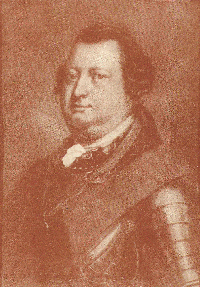 |
| |
Duke of Cumberland |
|
|
Castle of Blair. The
march of the Highlanders to Inverness was signalised by a narrow escape by
Prince Charles. On Sunday 16th February, with a small escort, he advanced to
Moyhall, with the intention of resting there till the arrival of the rest of
his men, and Lord Loudoun having been informed of this hurried from
Inverness with a force of 1500 men, in the hope of making him prisoner. Lady
MacIntosh was, however, apprised of the danger by a boy of the clan, who
from Inverness contrived to outstrip the military, and breathlessly in the
course of the night announced their approach. Being hastily summoned, the
selfpossessed hostess appeared "in her smock petticoat," and arrangements
were made for the Prince's withdrawing towards his advancing friends. The
lady had luckily used the precaution, taking counsel with Donald Fraser,
blacksmith at Moybeg, a shrewd and courageous man, to have a look-out on the
road from Inverness. Fraser accordingly, with the small number of four other
men, had taken up a position at a pass on the hill of Craig-an-Oin, at the
boundary between the parishes of Moy and Daviot, on a now disused portion of
General Wade's military road between Crieff and Inverness. Here they had
ensconced themselves at distant intervals behind some heaps of peat and turf
set up to dry. On the Royalists being descried in the dusk, the little party
at once comprehending the emergency, a command was passed by Donald, and
from man to man, in a stentorian voice, "The MacIntoshes, MacGillivrays, and
MacBeans to form the centre, the MacDonalds on the right, and the Frasers on
the left." A few shots were fired, when one of the advanced guard, a piper
of distinction, was killed. A panic seized the van: possibly, the force
consisting mainly of the Independent companies raised in the North, they had
no great zeal in their mission. So it is that the distracted commander,
conjuring the peat-hags into armed men, was so persuaded that he had the
Highland host confronting him, that he ordered his men rightabout. The whole
body fled with precipitation and in great confusion to Inverness. This
singular affair is characteristically styled, "The Rout of Moy." On the
Prince's advancing on February 18th to Inverness (via General Wade's bridge
50 yards to the west of the present Bridge of Faillie), he found Lord
Loudoun and his troops making the best of their way across the Moray Firth
at Kessock Ferry. |
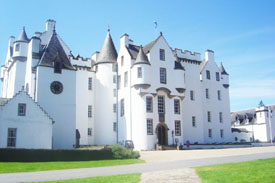 |
|
|
Bair Castle Atholl |
|
|
The Prince took up his
quarters in a house in Church Street, that of Lady Drummuir, mother of the
Laird of MacIntosh. It has been replaced by the large block of buildings
opposite old St. John's Episcopal Chapel. The style of social life in
Inverness at the period is indicated by the tradition, that it was the only
mansion in the town which had a sittingroom not serving the purpose also of
a sleeping apartment.
The Castle overhanging the river - where the County Buildings now stand -
would seem at this time to have been an imposing building, six storeys high,
with sharp-pointed roofs and turrets at the angles, and battlemented in the
finest style of old Scottish architecture. A couple of bastions, with
curtain-wall between, on the side of the |
|
ascent from the Castle
Wynd to the summit, are the only portions now remaining of the old
fortifications. This stronghold was then a government fort, and called Port
George. It was garrisoned by a party of Grants and MacLeods and of regular
troops, and. having shortly fallen into the hands of the Prince, was
destroyed by his orders, to the gratification of the Highlanders, who had a
rooted dislike to the government forts.
MINOR ENTERPRISES.
During the Duke of Cumberland's sojourn at Aberdeen, waiting the advance of
spring, several minor enterprises were conducted with skill and success by
his adversaries. Fort-Augustus was reduced. Lord Loudoun was pursued through
Ross-shire into Sutherland, and was dislodged from Dornoch by the Duke of
Perth, whose troops were ferried across from the vicinity of Tain in a
flotilla of boats which had been secretly collected at Findhorn, and carried
across the Moray Firth during the night by Moir of Stoneywood. The
Royalists, of whom a party were made prisoners, were followed to the head of
Loch Shin. Here the Mackays returned to their own country of Reay, and the
MacLeods made their way to Skye, accompanied by Loudoun and President
Forbes.
Lord John Drummond was posted at Fochabers in command of a detachment, and
his men were successful in some dashing skirmishes to the east of the Spey.
But the most noteworthy exploit was one by Lord George Murray, of which
General Stewart of Garth says in his Sketches, "I know not if the whole of
the Peninsular campaigns exhibited a more perfect execution of a complicated
military service." To obviate the danger of an apprehended concentration of
the Hessian troops and Argyleshire Highlanders in Athol, and, by the
reduction of Blair Castle, to keep the way unimpeded in case of a second
descent on the Lowlands; by way of retaliation, too, for reported excesses
on the part of the soldiery in that quarter; Lord George proceeded from
Inverness with a battalion of the Athol Brigade. Being Joined by a body of
MacPhersons under Cluny their chief, this force, to the number in all of
about 700 men, reached Dalnaspidal, in Drumouchter, the well-known pass
through the Grampians, and close by the foot of Loch Garry, on the evening
of the 10th March, and were told off into several parties, destined to the
attack of a number of outposts of the enemy, at different scattered points,
as far south as Fascally, garrisoned by the Campbell Highlanders, with
instructions to rendezvous at Bruar. Reckoning all the different houses so
occupied, there were not fewer than about thirty fortified stations. The
various expeditions met with brilliant success. Sir Andrew Agnew's picquets
near Blair, having reached the Castle and reported an enemy's presence, he
with a strong force sallied out in quest of the aggressors. |
|
Lord George was at the time
at the appointed rendezvous, with only four-and-twenty men, anxiously
awaiting the return of the assailing parties. It was essential for their
safety not to abandon their position. Having, fortunately, all the pipers
with him, ho ordered his men to secrete themselves at considerable intervals
behind a turf dyke. By the appearance of numbers, produced by the
brandishing of swords and din of the pipes in the uncertain dawn, the
regulars were brought to a halt, and their really brave commander, deeming
discretion for the nonce the better part of valour, marched his troops back
to the Castle, which the delighted Highland leader was speedily possessed,
by the return of his men, with the means of investing. The ordnance of the
besiegers proved of too light calibre to make any impression on the walls,
and the expedient of directing red-hot shot at the roof was
perseveringly practised, doing a good |
| |
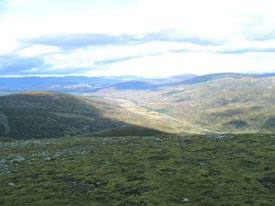 |
|
Looking along Drumochter
Pass |
|
|
deal of damage. The
Hessians would not venture through the Pass of Killiecrankie, and the
garrison were reduced to great straits, being unable to get intelligence of
their predicament communicated. But at last the Earl of Crawford, being
apprised of their situation, pressed to their relief, when he found the
leaguer abandoned, the Highlanders having been recalled to the North.
Fortune was unpropitious to Charles in the privation of supplies of money
forwarded from France. The vessels by which these were sent were in some
instances captured, and in others were unable to reach the coast, from the
vigilance of the English cruisers. But the Prince maintained his
cheerfulness notwithstanding, acting, as on almost all occasions during this
eventful episode of his life, in the spirit of the motto on a fowling-piece
which belonged to him, and which is now preserved at Auchnacarry,
"Tu ne cede malis sed contra audentior ito."
Considerable gaiety prevailed in Inverness to within a few days of the fatal
day when the clans of Culloden were scattered in fight.
The want of money was a most serious drawback; and it would appear from a
letter of Secretary Murray's dated at Fort-Augustus, 14th March, 1746, to
Lochiel, then engaged in the siege of Fort-William, that a plan of
operations at that time contemplated was that the Highland army should make
another descent on the Lowlands, with the view partly of replenishing the
military treasure-chest, and partly of withdrawing Cumberland from Aberdeen,
and thereby having the east coast left more open for friendly vessels from
abroad. The Insurgent leaders laboured also under a fatal disadvantage in
the lack of sources of authentic intelligence regarding the state of matters
in Aberdeenshire. It was commonly believed that the Duke's force was not
numerically one-half as strong as it really was; and this impression,
combined with his long delay there, wait for the advance of spring, seems to
have induced a degree of fatal security, and to have given rise to a notion
that he had no serious intention of attempting to penetrate beyond the Spey.
Whatever the causes, the dispersion of the various portions of the Prince's
army engaged in the disconnected services alluded to was allowed to continue
too long. They could not be recalled in the nick of time on the day of need
from such remote distances.
|
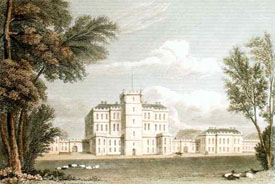 |
|
|
Gordon Castle Fochebers
1830 print |
|
|
In Sutherland there were
700 men left under the Earl of Cromartie, including MacDonald of Barrisdale,
MacGregor of Glengyle, and MacKinnon, with their men, after Lord Loudoun's
escape. Cromartie was cleverly kidnapped along with his son, Lord MacLeod,
by a party of the Earl of Sutherland's militia at Dunrobin. Cluny's men
remained in Badenoch, after Lord George Murray's return to Inverness. The
Camerons, and the Keppoch and some other MacDonalds, with the Stuarts of
Appin, were vainly attempting the reduction of Fort-William, ably defended
by Captain Scott; and though they did rejoin before the battle of Culloden,
it was with diminished numbers; while many men from the different regiments
had returned to their homes during seed-time. Provisions, too, had become
exceedingly scarce, and the Prince's army was reduced to |
|
a scanty supply of food,
and that of an inferior quality.
PASSAGE OF THE SPEY.
When he did move, Cumberland stole a march on his adversaries. Part of his
troops had already advanced as far as Strathbogie, and on the 8th of April
he left Aberdeen with the remainder; and, pushing on by Banff and Cullen, he
succeeded in crossing the Spey on the 12th, fording that deep and rapid
river at three places - at Garmouth, near Gordon Castle, and close by the
Church of Bellie. While the poor Highlanders were so insufficiently fed, the
Royal army was supplied by a fleet of victualling-ships, which coasted the
shores of the Firth. Lord John Drummond has been censured for not having
vigorously opposed the progress of the Royal army at the passage of this
river, which was regarded as a formidable barrier, where it had been
expected that Cumberland's advance might have been at least so far retarded
as to have given time for the full concentration of the clans. To protect
the fords some batteries were raised. But the Duke's artillery was so
powerful as to have forced a passage; and when Lord John abandoned the
position and fell back upon Inverness, his conduct was justified by Lord
George Murray. To dispute the passage with any chance of success, the whole
Highland army ought to have been on the spot; and, indeed, had the Prince's
contingent been complete in time, it is understood that he would have moved
forward to dispute the passage in earnest. The celerity of the Duke's
movements disappointed the calculations of his opponents, and, in the
absence of so large a proportion of their force, the presence of the Royal
troops on the west side of the Spey was the cause of great disquietude at
Inverness.
On the 14th the Royal army reached Nairn, and encamped at Balblair, and on
the heights of Kildrummie, west of that town, and within about 14 miles of
Inverness. The rear of the Highlanders, under Lord John Drummond, did not
quit Nairn till some shots had been exchanged. They were pursued by part of
the Duke's cavalry for some distance, but the Prince unexpectedly came up
with reinforcements. On the 15th, the Duke's birthday, the Royal army lay
inactive at Nairn, where they were regaled with extra cheer, and indulged in
festive relaxation. The Duke took up his quarters in the old portion, still
extant, of the house of Balblair, on the estate of Cantray.
[up^] |
|
|






